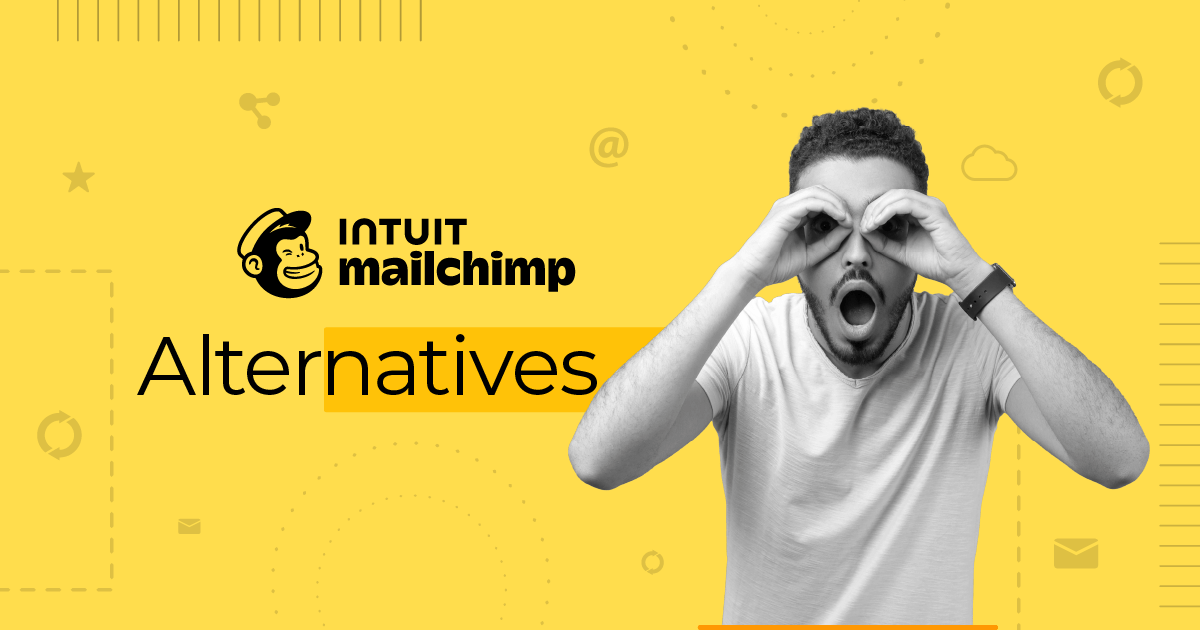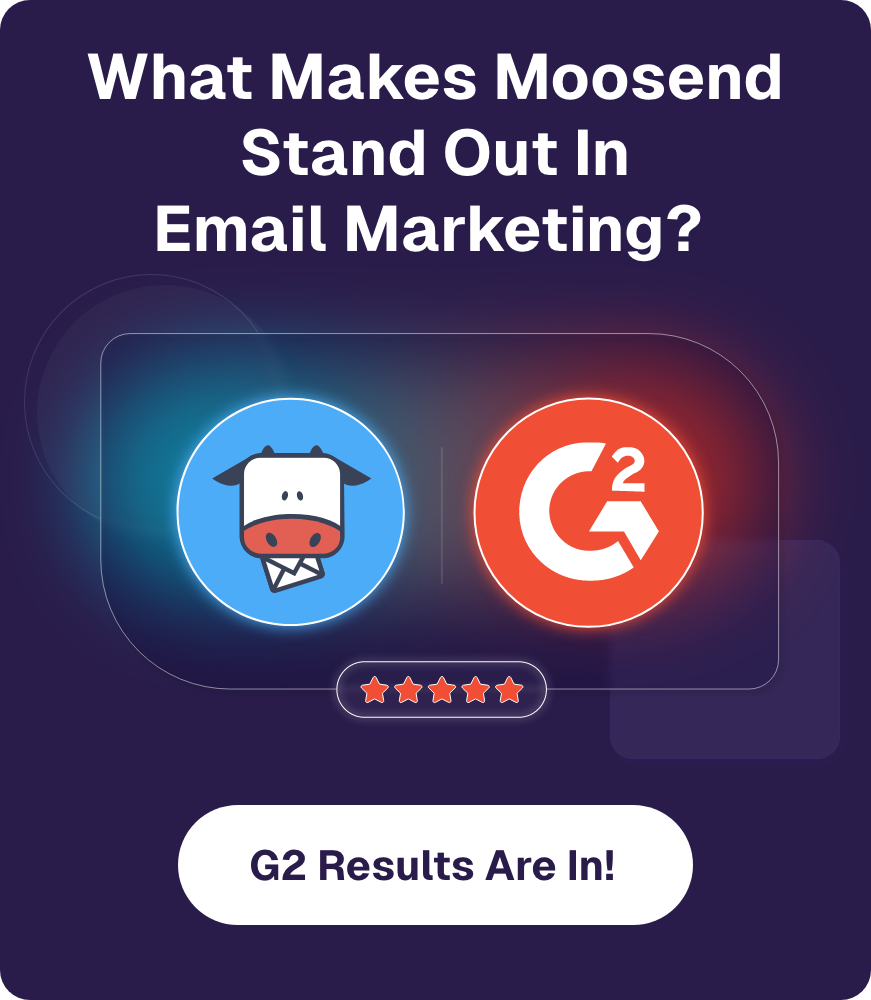
9 HubSpot Alternatives For 2025 [Free & Paid]
HubSpot has established itself as a household name for inbound marketing. Nevertheless, the marketing suite can become very expensive very quickly, which is less than ideal for growing businesses on a budget.
If you’re looking for an email marketing solution and CRM system that offers the same or better functionality at a lower cost, we’ll explore the best HubSpot alternatives for you to choose from.
What to Look for in a HubSpot Alternative
When evaluating a HubSpot alternative, it is essential to consider several key factors:
- Ease of use: A clean and modern UI helps you navigate the platform and explore its features. Easy onboarding is also beneficial.
- Marketing automation: You must be able to automate email campaigns, workflows, and lead nurturing.
- CRM functionality: This includes contact management options, deal pipelines, and activity tracking.
- Pricing: Ideally, the alternative you select should have affordable pricing that scales with your growth (unlike HubSpot, which gets expensive). You can also take advantage of free plans/trials to experiment with key features before committing.
- Customer support: No matter your level of experience with email marketing platforms, support will come in handy at some point. A responsive customer service team can prove useful if trouble comes your way.
Best HubSpot Alternatives: Compared
Before we show you the top HubSpot competitors in the market, let’s look at the following table to give you an idea of your best options for 1,000 subscribers.
| Price/Month | Free Plan/Trial | Unique Feature | |
| HubSpot | $20/month | Yes (limited) | Full growth/stack platform |
| Moosend | $16/month | Yes (30-day free trial) | Advanced audience segmentation |
| Pipedrive | $24/month | Yes (14-day trial) | Activities overview |
| ActiveCampaign | $19/month | Yes (14-day trial) | In-built CRM |
| EngageBay | $14.99/month | Yes (limited) | Visual multi-step automation |
| Freshsales | $11/month | Yes | Visual sales pipeline |
| Salesforce | $25/month | Yes (30-day trial) | High-level analytics |
| Adobe Marketo Engage | Request quote | No (demo only) | Campaign and journey automation |
| Zoho CRM | $20/month | Yes | AI-powered assistant |
| Klaviyo | $30/month | Yes (limited) | SMS marketing |
While HubSpot is an all-in-one solution that offers an advanced CRM environment to keep your contacts organized, it has a few cons that need to be addressed.
Firstly, the email service requires CSS knowledge regarding template customization compared to its competitors. What’s more, A/B testing is only available on the Pro Package, which has a quite high price tag if you just want the tool for simple use.
In the following sections, we’ll see some of the best competitors to HubSpot to help you solve the problems mentioned above.
Best Alternatives To HubSpot By Use Case
- Moosend — Best for affordable email marketing with advanced automation.
- Pipedrive — Best for SMBs wanting a sales-focused CRM.
- ActiveCampaign — Best for creating sophisticated automation journeys.
- EngageBay — Best free all-in-one CRM.
- Freshsales — Best for visual sales pipelines, workflows, and custom reports.
- Salesforce Account Engagement — Best for advanced sales automation.
- Adobe Marketo Engage — Best for enterprises in need of custom solutions.
- Zoho CRM — Best affordable CRM with AI features.
- Klaviyo — Best for advanced eCommerce functionality.
1. Moosend

Pricing: Paid plans start at $16/month, 30-day Free trial (Sign up here)
Best for: SMBs, eCommerce, SaaS, Enterprises
Unique feature: Advanced audience segmentation
Moosend’s all-in-one email marketing automation platform is perfect for building and managing your audience through newsletter signup forms, landing pages, and customer segmentation.
Regarding its email marketing tools, Moosend equips you with a user-friendly drag-and-drop editor to craft newsletters that convert. What makes it a great HubSpot alternative, though, is that you can fully customize the pre-made email templates without any CSS knowledge.
Moreover, the marketing automation tools let you automate your email marketing process through the visual workflow builder. You can set up welcome, abandoned cart, re-engagement, and other sequences in minutes. Unlike HubSpot, advanced marketing automation is available even on the entry Pro Plan, starting at $16/month. This is great for SMBs, considering that HubSpot’s automation features are available in the Professional package starting at $890/month.
Moving on to reporting and analytics, this alternative lets you track important email marketing metrics in detail. Compared to HubSpot’s reporting, Moosend’s custom reports let you create a personalized environment with the metrics that suit you best to minimize distractions.
Regarding pricing, paid plans start at $16/month for 1,000 contacts, giving you access to all major features without limitations.
Moosend Features
- User-friendly drag-and-drop email builder
- Fully customizable email templates (no CSS knowledge required)
- Audience management features
- Visual automated workflow editor
- Personalization feature for more targeted content
- Integrations with eCommerce tools, CRM, etc.
Pros
- Affordable pricing with powerful email marketing tools
- Visual automation builder with advanced triggers (e.g., cart abandonment, page visits).
- Responsive customer support
Cons
- No sales pipeline management or deal tracking
- Fewer native integrations
Moosend Pricing
This all-in-one solution offers three paid plans. The Pro plan starts at $16 per month for 1,000 subscribers and provides access to the form and landing page builder, SMTP server, real-time reporting, and audience management tools. The Moosend+ plan lets you add enterprise-level features to your account, such as transactional emails and audience discovery. Finally, there is an Enterprise plan with custom pricing.
If you want to try the tool, you can register for a free account and test all its main features.
HubSpot vs Moosend
Moosend is a more affordable solution than HubSpot, with fewer restrictions on automation and email sending. The user interface is beginner-friendly, and mastering the product requires a minimal learning curve.
On the other hand, HubSpot’s free CRM can be great for small businesses, but its entry-level plan comes with severe limitations.
| HubSpot | Moosend | |
| Best Feature | Full growth/stack platform | Advanced audience segmentation |
| Best for Industry | Enterprises, SMBs | SMBs, eCommerce, SaaS, Enterprises |
| Cons | Steep price tag, limited features on the Starter plan | Limited form customization, fewer integrations |
| Price | Starts at $20/month (1,000 contacts – 5,000 emails) | Starts at $16/month (1,000 subscribers – unlimited emails) |
| Free Plan/Trial | Yes (1,000 contacts – 2,000 emails) | Yes (1,000 subscribers – unlimited emails) |
2. Pipedrive
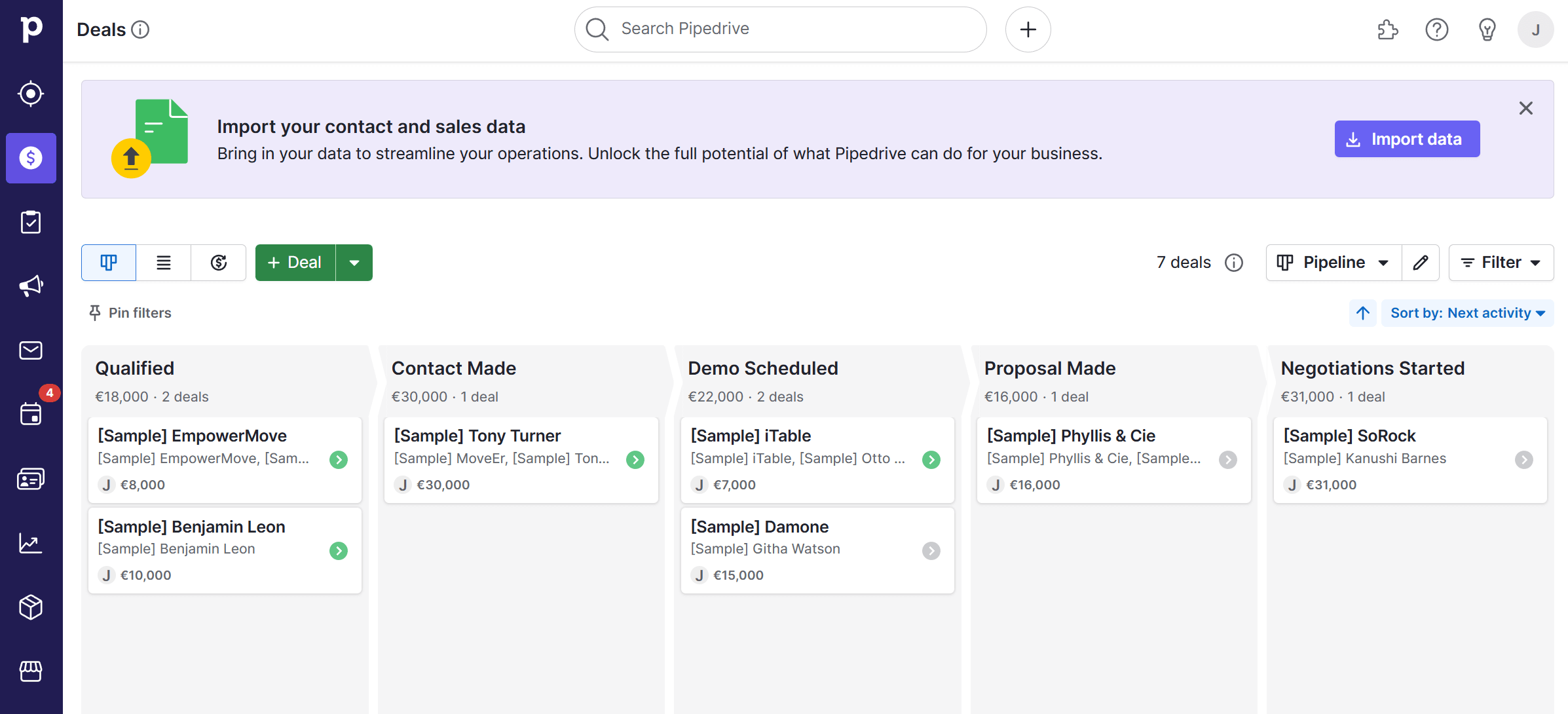
Pricing: Paid plans start at $24/month, 14-day free trial
Best for: Experienced marketers, SaaS, Agencies
Unique feature: Activities overview
Pipedrive is a worthy HubSpot sales CRM competitor, sporting an array of features to increase your lead generation and turn prospects into business customers. The user-friendly interface is easy to navigate, allowing you to monitor your sales and leads without distracting you.
Regarding pipeline management, Pipedrive offers the same customization options as HubSpot, allowing you to add your deals, drag them between columns when a change occurs, and add custom elements. If you want to keep in touch with your leads, Pipedrive has numerous integrations with email marketing tools like Moosend. Please note that the platform itself does not offer email marketing (available as an add-on).
Reporting-wise, this competitor lets you track your performance through the Insights Dashboard. Customs reports are also available, but you won’t need to pay $500 to access them like in HubSpot’s case.
Overall, the two platforms offer similar features and functionality. Nevertheless, Pipedrive is more geared toward sales, while HubSpot favors marketing. The main difference, though, is the price. Pipedrive’s Professional plan starts at $69/month, while HubSpot’s starts at $890, which is significantly higher and not ideal for smaller businesses.
Pipedrive Top Sales CRM Features
- Visual pipeline of sales stages
- Activities overview
- Custom data columns and filters
- Customizable email templates
- Scheduler and unified calendar
- Communication tracking
Pros
- Great sales CRM (for managing deals, follow-ups, stages)
- Robust workflow automation with AI sales assistant
- Extensive integrations library
Cons
- Full email marketing functionality costs extra (Campaigns add-on)
- Advanced reporting and forecasting features are only in higher-tier plans.
Pipedrive Pricing
While there is no free plan, Pipedrive offers a 14-day free trial. After that, you need a subscription plan, starting with the Essential plan at $24/month (billed monthly).
HubSpot vs Pipedrive
Pipedrive’s pricing plans are more reasonably priced (starting at $24/month per user) and increase incrementally with your growth. You get many customization options and dashboard features, while the tool also has great reporting capabilities.
Despite their similarities, HubSpot delivers an all-in-one solution with email marketing, forms, and landing pages included (even in the free plan). If your business can make do with HubSpot’s free solution, then Pipedrive might be overkill for you.
| HubSpot | Pipedrive | |
| Best Feature | Full growth/stack platform | Activities overview |
| Best for Industry | Enterprises, SMBs | SMBs |
| Cons | Steep price tag, limited features on Starter plan | Full email marketing functionality costs extra |
| Price | Starts at $20/month | Starts at $24/month |
| Free Plan/Trial | Yes | Yes (14-day trial) |
3. ActiveCampaign
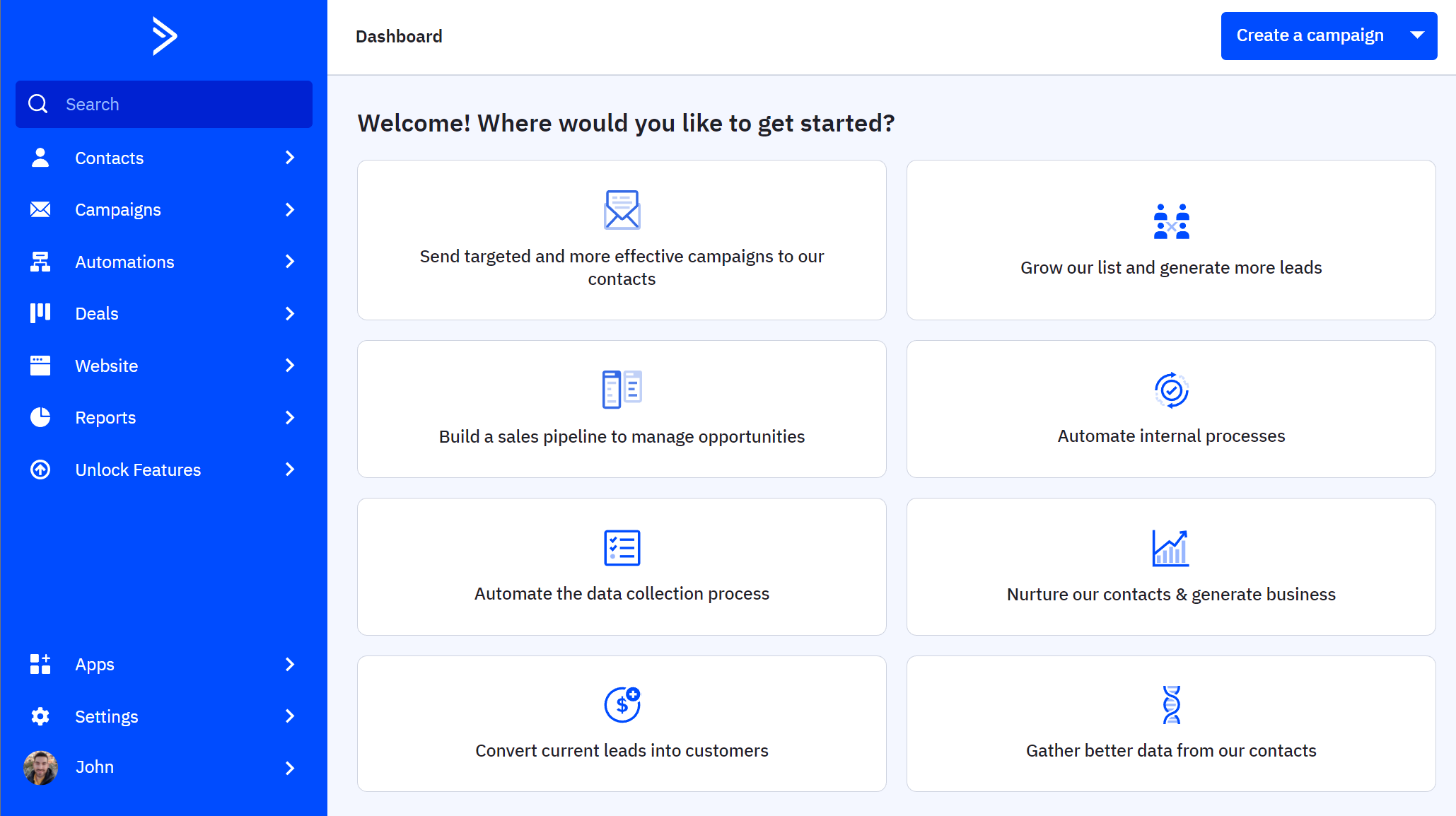
Pricing: Paid plans start at $19/month, 14-day free trial
Best for: Experienced marketers, SaaS, Agencies
Unique feature: In-built CRM platform
ActiveCampaign is a HubSpot alternative known for its powerful marketing automation capabilities. Like HubSpot, this platform offers tools to boost your marketing, sales, and customer relationship management efforts at more affordable pricing plans.
More specifically, this marketing automation software will provide you with an advanced workflow editor to set up your follow-up campaigns and smart sequences. Nevertheless, if you want something simple with a short learning curve, the platform may not be for you, unlike other ActiveCampaign competitors.
Apart from its email marketing and automation features, the platform has an in-built lead management system with sales automations to simplify your sales process. You can use it to watch your leads’ history and create a lead scoring system to determine their value. On top of that, you can update contact details easily and even use the Calendar Feed feature to sync tasks with Google Calendar, Microsoft Outlook, or any other calendar with a subscription option.
The reporting and analytics that ActiveCampaign offers are more insightful than HubSpot’s, allowing you to create automation and eCommerce reports for your online business. Lastly, this alternative to HubSpot offers an extensive list of integrations to streamline your business, including apps such as Shopify, Salesforce, and WordPress.
ActiveCampaign Best Advanced Features
- Advanced email automation features
- Sales drip campaigns
- Pop-ups
- Autoresponders
- Gmail and Outlook sync through extensions
- Campaign and automation reporting
Pros
- Advanced automation capabilities (huge library of pre-built journeys)
- Great email deliverability
Cons
- Steep learning curve
- CRM reports could be more customizable
Pricing
You can try ActiveCampaign’s features by signing up for the 14-day trial. After the trial period, you will need a paid subscription plan, starting at $19/month for 1,000 subscribers and basic functionality. For the Sales CRM add-on, you’ll need an additional $49/month.
HubSpot vs ActiveCampaign
ActiveCampaign offers top-notch automation options, a variety of sales and marketing features as well as a built-in CMS. Moreover, the drag-and-drop functionality in the workflow builder is something that HubSpot lacks.
HubSpot, on the other hand, is a tad more customizable, allowing you to update the dashboard and integrate custom reporting widgets.
| HubSpot | ActiveCampaign | |
| Best Feature | Full growth/stack platform | In-built CRM |
| Best for Industry | Enterprises, SMBs | Small businesses, SMBs, Enterprises |
| Cons | Steep price tag, limited features on Starter plan | Limited dashboard customization options |
| Price | Starts at $20/month (1,000 contacts – 5,000 emails) | Starts at $19/month (1,000 contacts) |
| Free Plan/Trial | Yes (1,000 contacts – 2,000 emails) | Yes (14-day free trial) |
4. EngageBay
Pricing: Paid plans start at $14.99/month, free plan
Best for: SMBs, Startups, Solopreneurs
Unique feature: Advanced visual, multi-step automation
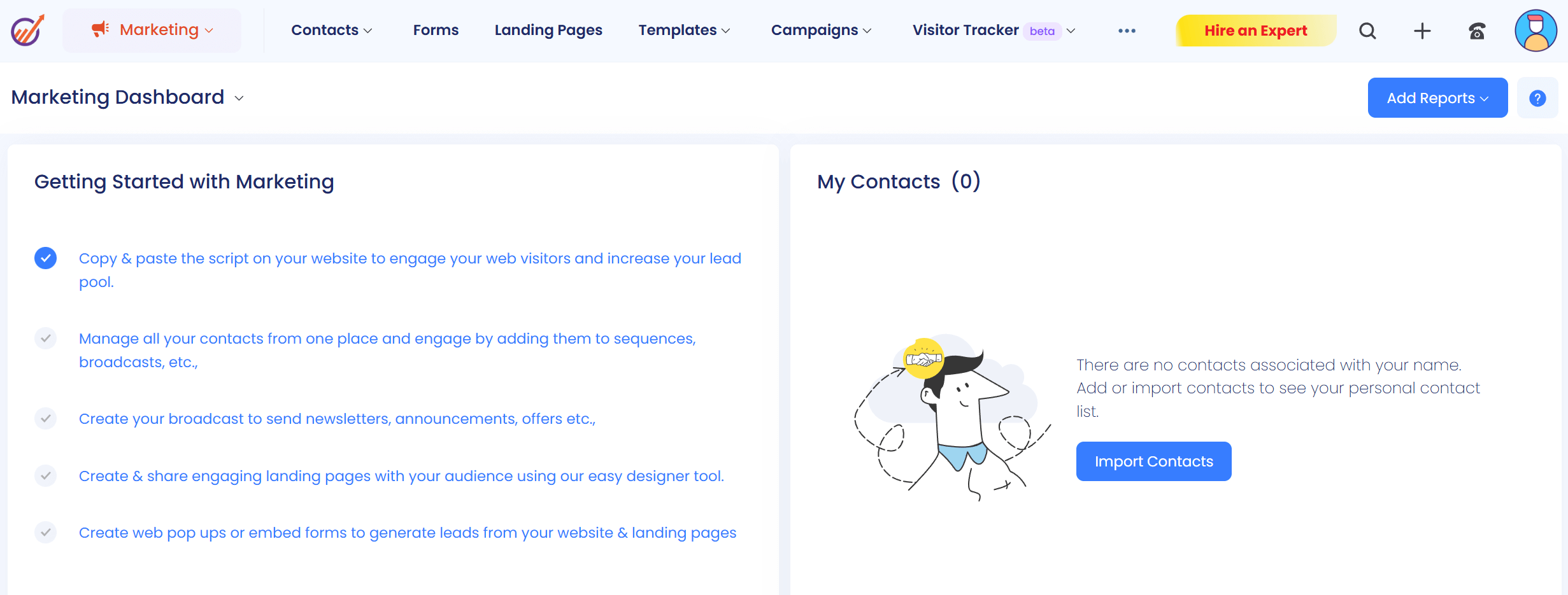
Another great HubSpot alternative on our list is EngageBay, a truly all-in-one CRM software with marketing, sales, and customer support automation. EngageBay’s tools help you automate multiple aspects of your business, including lead generation, drip campaigns, deal tracking, support tickets, and more.
EngageBay offers landing pages and lead forms to help capture lead data. You can then nurture these leads through various marketing campaign options. You can also customize your campaigns and marketing content based on advanced customer segmentation – this helps personalize and tailor your content, resulting in better conversions.
Sales reps can then move qualified leads down the funnel using multiple sales automation tools. Through automation, you can also upsell and cross-sell to your customers by targeting them at with the right content at the right time. Helpdesk, ticket prioritization, auto-assignment, chatbot, and autoresponders all work together to reduce time and resources while improving customer experience.
In a nutshell, EngageBay is perfect for small businesses looking for an affordable, all-in-one CRM solution to increase their ROI.
EngageBay Top CRM Features
- Multistep visual automation builder
- Omnichannel marketing
- A/B testing
- Advanced customer segmentation
- Helpdesk and livechat
- 360-degree customer view
Pros
- Setting up automation is effortless
- Live chat plus help desk built-in
Cons
- Limited free plan
- Basic reporting
- Initial setup can feel overwhelming
EngageBay Pricing
EngageBay offers a free plan for up to 15 users and three paid plans. The Basic plan starts at $14.99/month for 500 contacts, and the Growth plan costs $64.99/month for 5,000 contacts, including marketing automation and A/B testing. The Pro plan offers unlimited contacts, web analytics, a dedicated account manager, custom options, and more for $119.99/month.
HubSpot vs EngageBay
EngageBay offers affordable plans compared to HubSpot, but with similar features. The Pro plan offers unlimited contacts for a fixed price, while HubSpot’s cost shoots up as the number of contacts grows.
HubSpot is targeted towards mid-range companies and enterprises, while EngageBay is geared towards SMBs and solopreneurs.
| HubSpot | EngageBay | |
| Best Feature | Full growth/stack platform | Multi-step, visual automation builder |
| Best for Industry | Enterprises, SMBs | SMBs, Startups, Solopreneurs |
| Cons | Steep price tag, limited features on Starter plan | No marketing automation on the free plan |
| Price | Starts at $20/month (1,000 contacts – 5,000 emails) | Starts at $15/month (500 contacts) |
| Free Plan/Trial | Yes (1,000 contacts – 2,000 emails) | Yes (250 contacts – 2,000 emails) |
5. Freshsales
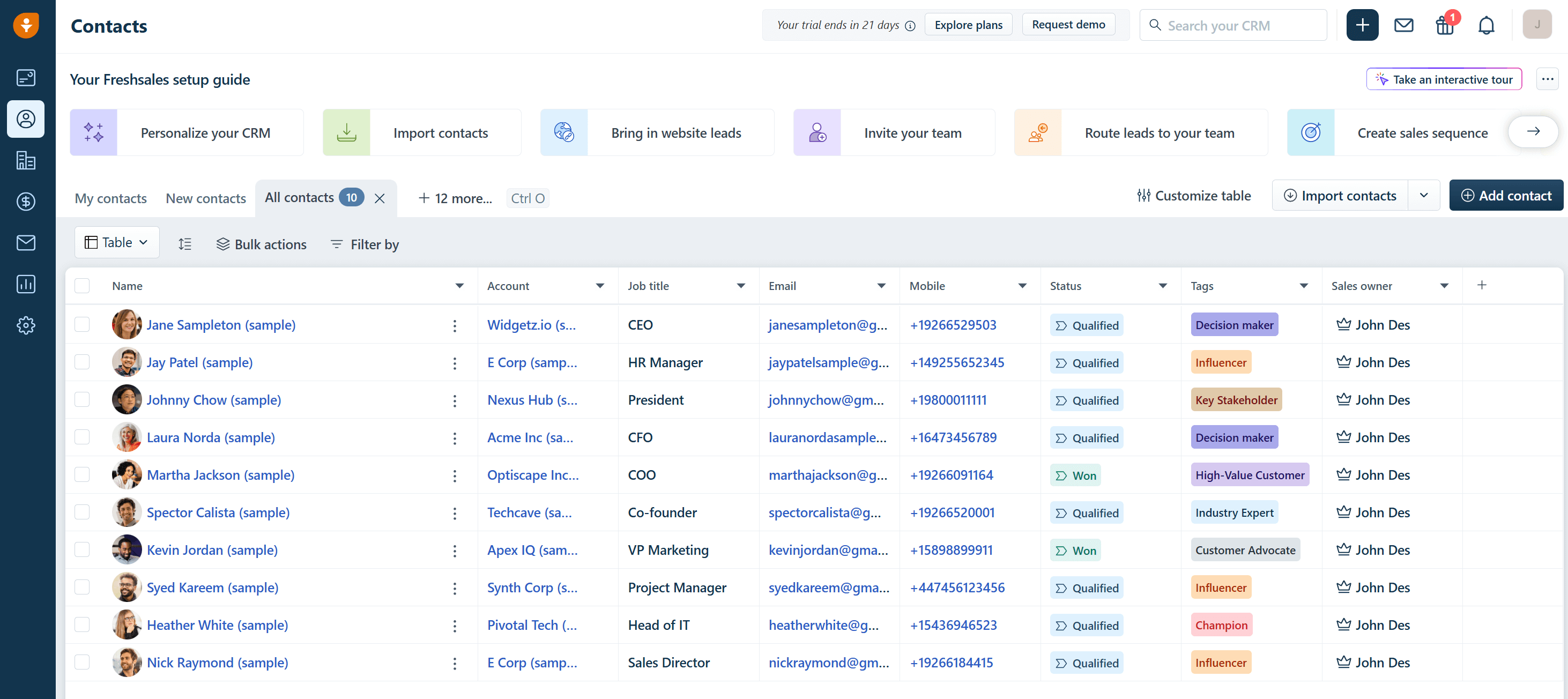
Pricing: Paid plans start at $11/month, free plan
Best for: Startups, Small businesses, Sales teams
Unique feature: Visual sales pipeline
Freshsales is a sales CRM software that offers sales and marketing teams a series of tools to power up their lead generation efforts. Users can benefit from this HubSpot competitor in terms of features and affordability.
To increase your lead generation, you can use AI-powered chatbots and web forms to capture your website visitors’ contact information. When you collect your leads, Freshworks will allow you to monitor your deal status through visual sales pipelines.
Moreover, you can use the AI predictive contact scoring feature to receive a score based on specific customer data. This will help you identify hidden opportunities and then use specific sales sequences to nurture your leads into customers.
In addition, Freshsales comes with time-based workflows, an essential feature for streamlining daily tasks and saving valuable time. Last but not least, this contact management system allows you to cross-sell and upsell to your customers through automated sales campaigns that target them at the right time.
Overall, Freshsales is a great HubSpot CRM alternative offering a user-friendly UI, an array of customizations, robust features, and more reasonable pricing.
Freshsales Top CRM Features
- Sales funnel insights
- Visual sales pipeline
- Mobile app for easier access
- Automated sales campaigns
- Dedicated customer support team
Pros
- AI-powered sales functionality
- Strong automation engine (with visual automation builder)
Cons
- Marketing tools aren’t as powerful as HubSpot’s marketing suite
- Smaller ecosystem that can feel restrictive for some setups
Pricing
Freshsales offers a free CRM plan that enables sales teams to engage with their leads effectively. For the visual pipelines, lead scoring, sales sequences, and increased bot sessions, you need one of the paid options, starting at $11, $47, and $71 per month (billed monthly).
HubSpot vs Freshsales
Freshsales has a much simpler pricing structure than HubSpot. The tool has a nice drag-and-drop deal pipeline view, and the interface is easy to read overall.
HubSpot has more detailed reports than Freshsales, and its CRM allows up to 1M non-marketing contacts, which is pretty generous.
| HubSpot | Freshsales | |
| Best Feature | Full growth/stack platform | Visual sales pipeline |
| Best for Industry | Enterprises, SMBs | Startups, Small businesses, Sales teams |
| Cons | Steep price tag, limited features on Starter plan | No reports available on free plan |
| Price | Starts at $20/month (1,000 contacts – 5,000 emails) | Stars at $11/month (1,000 contacts – 5,000 emails) |
| Free Plan/Trial | Yes (1,000 contacts – 2,000 emails) | Yes (1,000 contacts) |
6. Salesforce

Pricing: Paid plans start at $25/month, 30-day free trial
Best for: SaaS, Startups, Enterprises
Unique feature: High-level analytics
Salesforce Starter Suite is an all-in-one CRM solution designed for small businesses or teams new to Salesforce. It offers sales, service, and marketing tools in one place, making it a great starting point for companies that want the power of Salesforce without the complexity or price of its full-scale products.
Unlike HubSpot, which heavily emphasizes content marketing and inbound strategy, Salesforce Starter prioritizes customer and pipeline management. It offers built-in email communication, lead tracking, deal pipelines, and support ticketing. It’s ideal for companies that want better visibility across the customer lifecycle while staying within a simplified and affordable system.
Another strength of Salesforce Starter is its focus on customer support integration right out of the box. While many CRMs require separate tools for managing cases or tickets, Starter includes service functionality natively, allowing businesses to resolve customer issues alongside ongoing sales conversations. This makes it particularly useful for small B2B or service-oriented companies needing consistent post-sale engagement without investing in additional platforms.
Finally, Salesforce Starter is also a smart choice for teams that want a future-proof CRM. Though simplified, it uses the same underlying Salesforce infrastructure, meaning you can connect with Salesforce AppExchange tools, add users, and upgrade to more advanced plans as your business evolves.
Salesforce Best Features
- Personalized content generation
- Built-in lead and deal management
- Workflow automation
- Ticketing tools for sales and support teams
- Guided onboarding and setup
Pros
- All-in-one unified CRM solution
- Designed for fast implementation
- Built-in case management
Cons
- Lacks advanced automation, A/B testing, or behavior-based triggers
- Costs rise quickly when adding more users and contacts
Pricing
Salesforce Starter Suite starts at $25/month per user. There are also more expensive packages offering advanced functionality starting at $1,250/month.
HubSpot vs Salesforce
Salesforce offers a more customizable interface, which may be valuable for some users, but at the same time, it is more complicated.
HubSpot is primarily an inbound marketing tool, while Salesforce is more closely associated with sales automation.
| HubSpot | Salesforce | |
| Best Feature | Full growth/stack platform | High-level analytics |
| Best for Industry | Enterprises, SMBs | SaaS, Startups, Enterprises |
| Cons | Steep price tag, limited features on Starter plan | No advanced automation and A/B testing |
| Price | Starts at $20/month (1,000 contacts – 5,000 emails) | Starts at $25/month |
| Free Plan/Trial | Yes (1,000 contacts – 2,000 emails) | Yes (2,000 leads/contacts – 10 emails/day) |
7. Adobe Marketo Engage
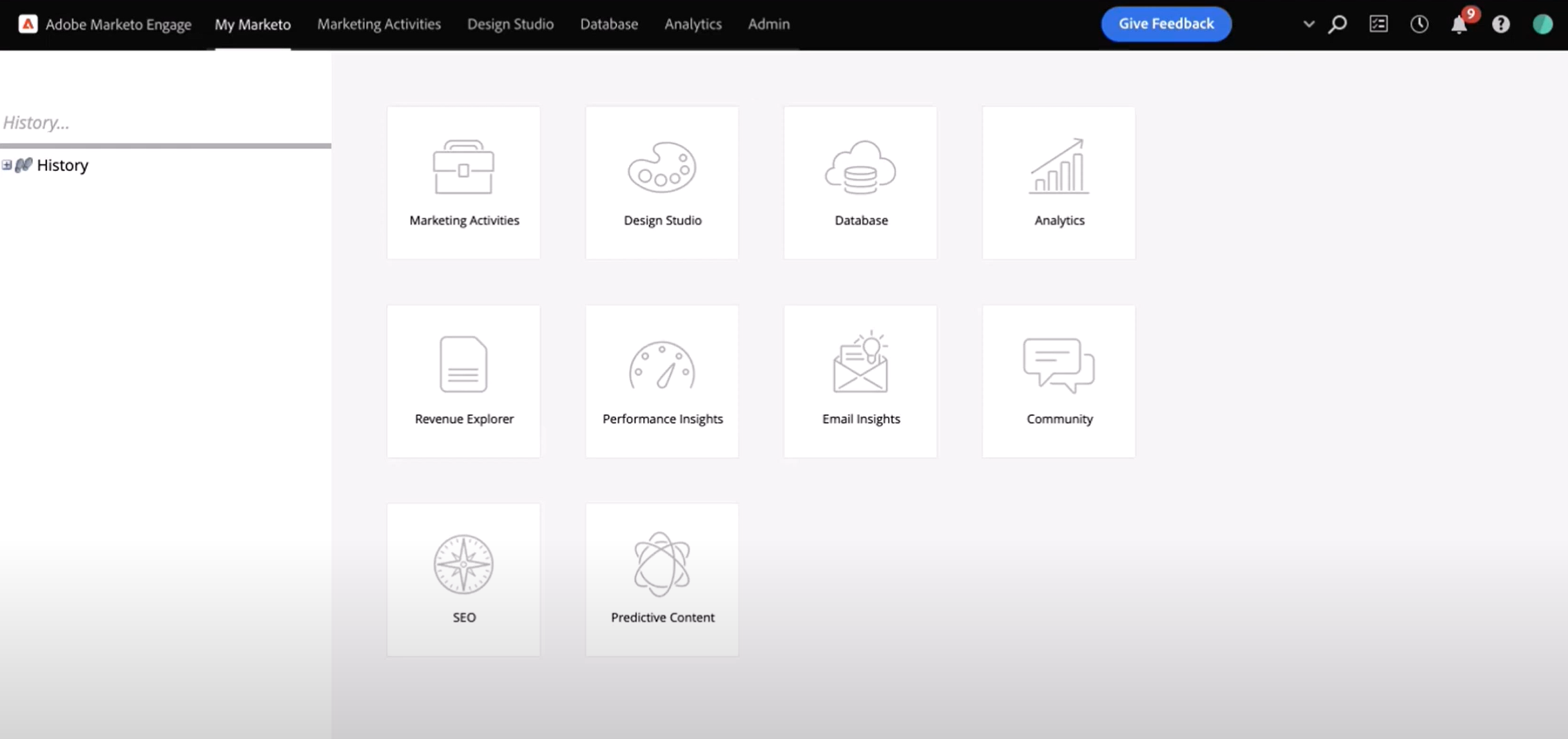
Pricing: Request a quote, Demo
Best for: SaaS, Enterprises
Unique feature: Campaign and journey automation
Adobe Marketo Engage is among the top HubSpot alternatives that’ll provide you with email marketing automation features, lead management, and revenue attribution tools.
When it comes to email marketing, the platform will let you use the visual email builder to craft targeted email campaigns to capture your subscribers’ attention. For better conversions, Marketo also equips you with advanced personalization tools to ensure that each experience is tailored to your target audience.
On top of that, marketing automation features are also available to craft automated campaigns that will increase engagement and target the right person at the right time.
Regarding lead management, Marketo integrates with Salesforce CRM and Microsoft Dynamics to help your sales team identify the best opportunities. Furthermore, the powerful reporting and analytics will enable you to monitor your sales funnel and perform any necessary optimizations to boost your revenue.
And speaking of that, Marketo Engage also allows you to track the B2B customer journey and channel engagement (paid media, email marketing, etc.) to increase your performance and ROI.
Looking for alternatives to Marketo? Check them here!
Marketo Engage Best Email Service Features
- Email marketing options
- Campaign and journey automation
- CRM integration
- Attribution & ROI dashboards
- Event & webinar marketing
Pros
- Enterprise-grade marketing automation (multi-touch attribution, dynamic content)
- Powerful lead management
Cons
- High cost (and usually long contracts)
- No native CRM
- Lengthy onboarding and configuration period
Pricing
This HubSpot alternative offers four different paid plans with features that’ll help you boost the customer experience. To determine the price of each package, you’ll need to contact sales and request a quote.
HubSpot vs Marketo Engage
| HubSpot | Marketo Engage | |
| Best Feature | Full growth/stack platform | Campaign and journey automation |
| Best for Industry | Enterprises, SMBs | SaaS, Enterprises |
| Cons | Steep price tag, limited features on Starter plan | Reporting & analytics could be improved |
| Price | Starts at $20/month (1,000 contacts – 5,000 emails) | Request quote |
| Free Plan/Trial | Yes (1,000 contacts – 2,000 emails) | No |
8. Zoho CRM

Pricing: Paid plans start at $20/month, free plan
Best for: eCommerce, SMBs, Enterprises
Unique feature: AI-powered conversational assistant
Zoho CRM is a great customer management alternative to HubSpot’s Sales Hub, offering three different ways to view your contact details and deals.
One of the best features you can leverage is the powerful filtering options that the tool provides. For instance, you can find leads based on activity, such as meetings and calls.
If you are worried about your sales, Zoho CRM has developed Zia, a conversational assistant who will help you predict the outcome of your new deal and assign a lead score to them.
Moreover, you can use Zia to identify potential sales anomalies to come up with instant solutions. Compared to HubSpot, Zoho CRM offers more detailed reports and insightful predictions to help you improve your ROI.
Overall, Zoho’s unified CRM is ideal for those who want an easy-to-use tool to improve the customer experience and make their marketing and sales team collaboration easier. Plus, Zoho CRM integrates with the rest of Zoho’s products (Campaigns, etc.), giving you a tool that resembles HubSpot but at a significantly lower price.
Zoho Best CRM Features
- Conversational AI assistant
- Advanced customization
- Mass email
- Real-time customer notifications
Pros
- Variety of pre-defined reports
- Powerful AI data analysis and predictions (available on more expensive plans)
Cons
- Steep learning curve for non-technical users
- Inconsistent UI across products of the Zoho family
Pricing
Zoho CRM has a free version for up to 3 users with essential functionality. For more, you can select among four different paid options, starting at $20/month with the Standard Plan, which includes mass email, workflows, and sales forecasting.
HubSpot vs Zoho CRM
Zoho CRM offers 3 different views (kanban, canvas, and tubular) for contacts, leads, accounts, and deals (unlike HubSpot, which only has 2). Moreover, what’s unique about Zoho is the Activities section, allowing you to filter by activity type, e.g., open tasks, tomorrow’s meetings, all calls, and more.
HubSpot has a slicker, more intuitive interface than Zoho and it provides users with a great onboarding experience.
| HubSpot | Zoho CRM | |
| Best Feature | Full growth/stack platform | AI-powered assistant |
| Best for Industry | Enterprises, SMBs | Small businesses, eCommerce, SMBs, Enterprises |
| Cons | Steep price tag, limited features on Starter plan | No support on free plan |
| Price | Starts at $20/month | Starts at $20/month |
| Free Plan/Trial | Yes | Yes |
9. Klaviyo
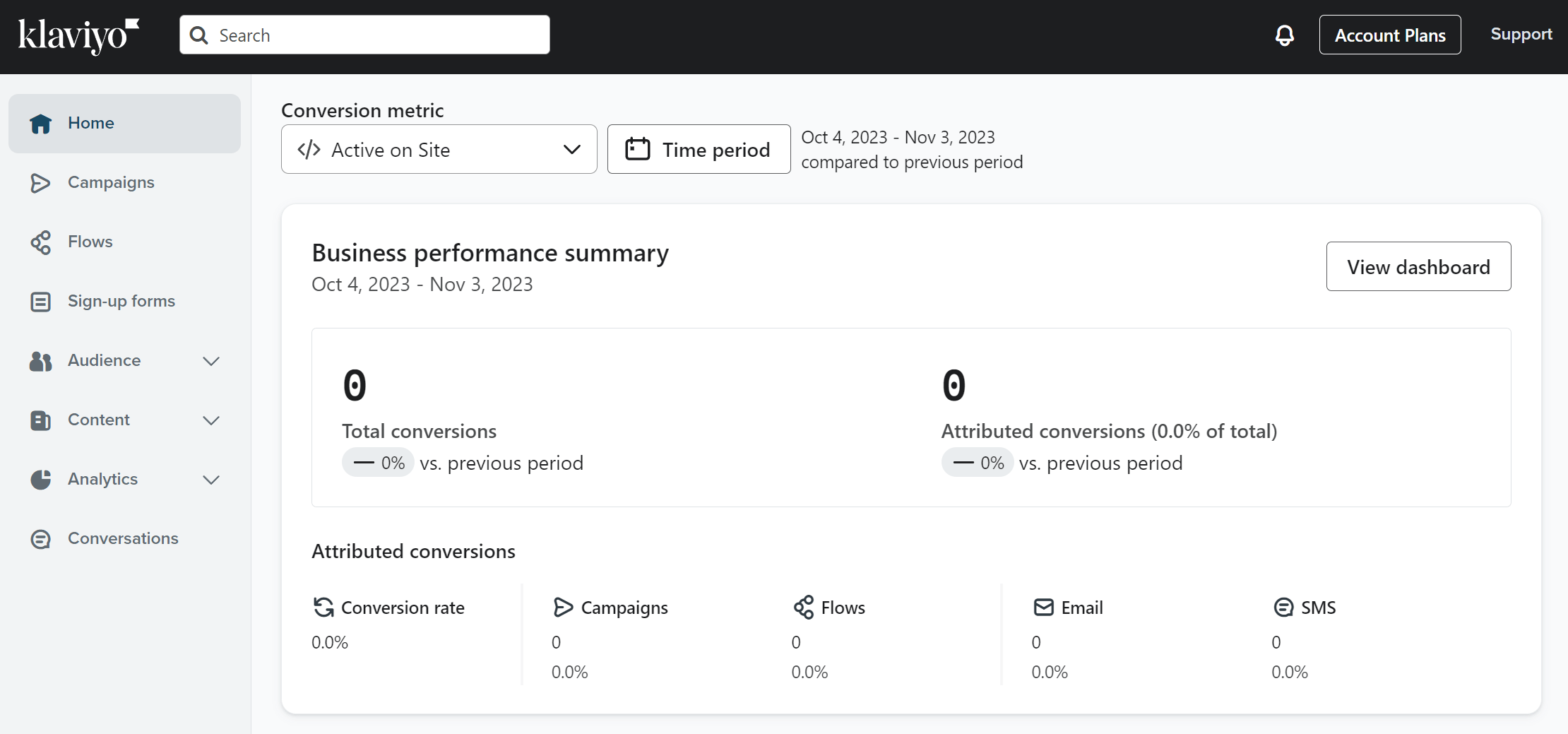
Pricing: Paid plans start at $30/month, free plan
Best for: eCommerce, Startups
Unique feature: SMS marketing options
Klaviyo’s eCommerce-oriented email marketing platform is a great HubSpot alternative for online store owners who don’t want to spend a fortune on email marketing tools. The drag-and-drop editor is easy to use and has numerous pre-made templates to simplify the design process.
Moreover, you can set up automated workflows like welcome and abandoned cart sequences to deliver personalized content to your audience. Transactional emails are also available through the SMTP server to create and send order notifications, invoices, and status updates to your customers.
Klaviyo’s reporting and built-in benchmarks will let you monitor your campaign performance and even compare your metrics with your competitors’.
This email platform also offers SMS marketing options to keep your customers informed about price drop alerts, abandoned cart reminders, and shipping updates. To collect their phone numbers, you have multi-step and click-to-text web forms, click-to-text email banners, etc.
Klaviyo Best Email Tool Features
- Conversational AI assistant
- Transactional email campaigns
- SMS marketing features
- Built-in benchmarks
Pros
- Powerful personalization with dynamic product blocks, customer tags, and behavioral data
- Best-in-class eCommerce integrations
- Advanced segmentation (requires familiarity, though)
Cons
- The automation system is powerful but requires careful setup
- The platform can be limiting for non-eCommerce use cases
- No deal pipeline, task management, or sales automation
Pricing
While Klaviyo offers a free plan, it is limited to 250 contacts and 500 email sends. If you want more functionality and increased limits, you have to purchase a paid plan, starting at $30/month for 1,000 subscribers and 10K email sends.
HubSpot vs Klaviyo
Klaviyo is heavily oriented towards eCommerce businesses, and as such, it provides immense value to eCommerce store owners.
HubSpot, on the other hand, offers a more comprehensive set of inbound marketing tools, along with a robust CRM to enhance your sales operations.
| HubSpot | Klaviyo | |
| Best Feature | Full growth/stack platform | SMS marketing options |
| Best for Industry | Enterprises, SMBs | eCommerce, Startups |
| Cons | Steep price tag, limited features on Starter plan | Slow customer support, steep price |
| Price | Starts at $20/month (1,000 contacts – 5,000 emails) | Starts at $30/month |
| Free Plan/Trial | Yes (1,000 contacts – 2,000 emails) | Yes (250 contacts – 500 emails) |
How We Selected The Tools
All of the tools in this list have been tested by our team to provide an unbiased description of its features and capabilities.
We spent hours setting up new accounts and trying each software to provide an accurate experience and show users exactly what they will come across when they sign up. Find more information about our software selection methodology on how we choose tools to feature on the Moosend Blog.
The Best HubSpot Competitor For You
HubSpot is undoubtedly a great all-in-one platform to help you grow your business. However, the steep pricing model, the potential difficulty in customizing templates, the lack of features in the less expensive plans, and the additional charges for technical assistance may not be ideal for every business.
If you want to scale your company, you should start looking for a great alternative to offer you the same functionality as HubSpot but at a lower price. Tools like Moosend, ActiveCampaign, and Marketo Engage are some solutions you can choose to power up your marketing and sales without breaking the bank.
If you still haven’t made up your mind, why not take advantage of the free plans and trials to test your new tool? You can easily try Moosend by registering for a free account to test the core features before committing.
Frequently Asked Questions (FAQs)
Looking for the most frequently asked questions regarding HubSpot alternatives? Here they are.
1. What is the best HubSpot alternative?
Some of the best Hubspot alternatives include Moosend, Pipedrive, ActiveCampaign, and EngageBay. Each solution has its loyal customers and is best suited for different needs. For example, Moosend delivers an affordable yet robust marketing platform, Pipedrive focuses on providing a powerful sales CRM, ActiveCampaign has sophisticated automation options, while EngageBay allows businesses to deliver a multi-channel experience.
2. Is HubSpot worth it for small businesses?
HubSpot can be worth it for a small business depending on the budget and feature needs. HubSpot’s entry-level plan provides reliable tools for email marketing, but limited automation. Many advanced features are locked behind the Professional plan. So, if you want a tool for basic email marketing needs, HubSpot will be ideal. Otherwise, you should also take a look at other alternatives.
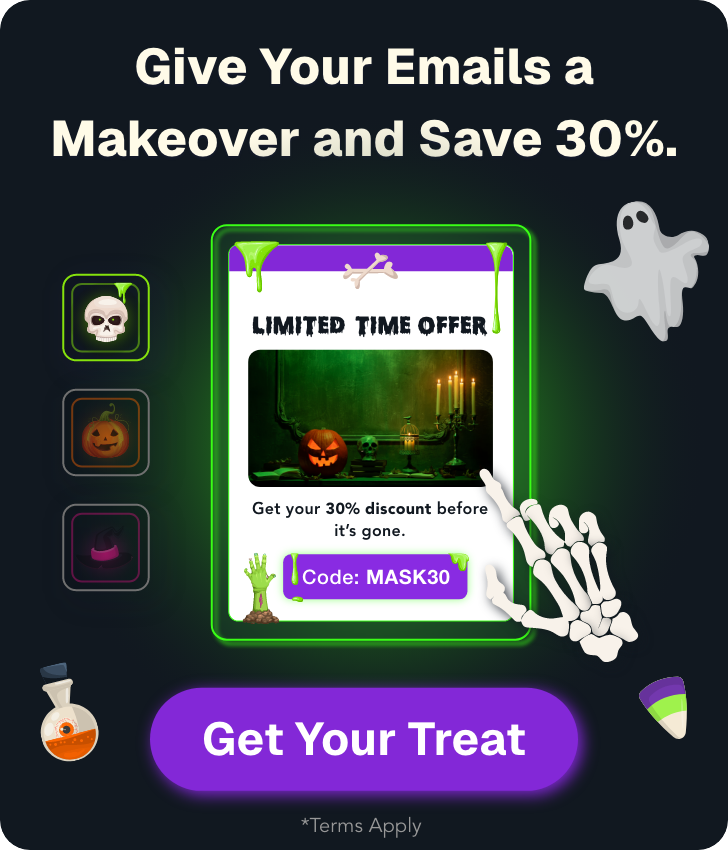


 Published by
Published by

